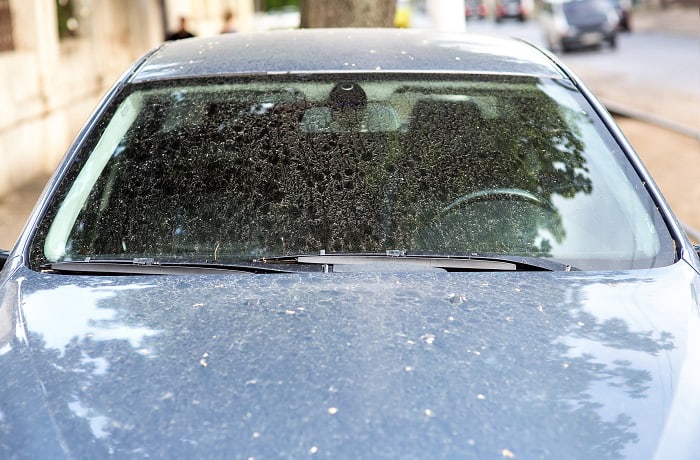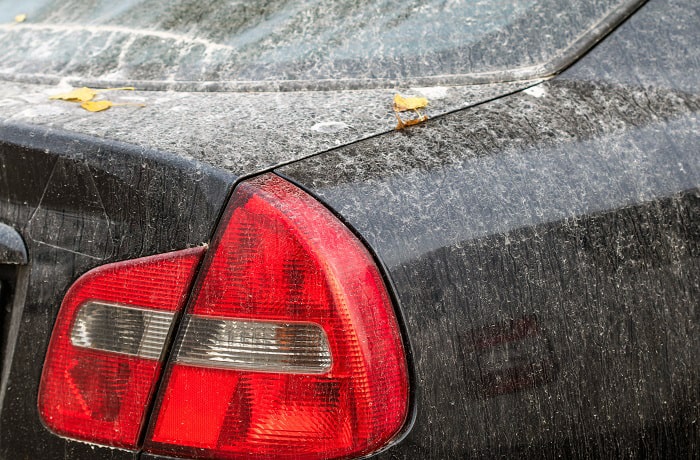Hard water refers to water that is rich in minerals such as magnesium and calcium. And even though hard water may be great for gardening thanks to its high mineral content, it is not so good for auto glass.
When your car windows are exposed to hard water, eventually the water is going to evaporate but the minerals won’t.
The minerals left behind create white spots and are commonly referred to as lime scales. Hard water stains don’t just create an annoying haziness on your windows but they are very hard to clean.
If you have been struggling with removing hard water stains and you have just come across CLR, you may be wondering if can I use it to clean calcium deposits on auto glass.
CLR is known in full as Calcium, Lime, and Rust Remover. And yes, it can help you remove hard water stains from auto glass.
However, before you rush to grab some and pour it on your windshield or car windows, you might want to read what we have for you below on CLR and its ability to remove hard water stains from auto glass.

Can CLR Clean Hard Water Stains from Auto Glass?
As mentioned earlier, yes it can. When it comes to the removal of calcium and lime deposits from glass, there is no better remover than CLR.
However, this is a product that is mostly used on household glass. And that raises the concern, is it safe to use CLR on auto glass?
Unlike bathroom glass, auto glass is very delicate. Plus, it may contain some treatments and products like a tint.
Moreover, it is surrounded by plastic and car paint which is also vulnerable to damage especially when exposed to harsh products such as CLR.
If you are dealing with hard water stains on your car and haven’t gained much success with car shampoos and other cleaners, it is worth giving CLR a try.
But, first, we recommend that you dilute. When you open CLR, the smell is enough proof of how strong it is.
Therefore, dilute it in water dab some on a microfiber cloth, and then wipe on the glass. Don’t be very generous with the solution as it may spill and etch through paint.
Rub the CLR and water mixture on the car windows until the entire surface is covered. Let it sit for a minute. Clean off the residue gently and then rinse it off with water.
Your auto glass will be clean and clear, and all the hard water stains will be removed.
CLR is acidic and that’s why it is so effective at removing hard water deposits because Calcium is an alkali. However, CLR is only safe for use on glass and nothing else.
Ensure that when using it to clean hard water stains on auto windows, the content doesn’t run off to the paint, plastic, or other surfaces on your car.
✔ Blasts Away Buildup – Quickly removes calcium, lime, rust, hard water stains, and soap scum from kitchens, bathrooms, and beyond.
✔ Non-Toxic, Industrial Strength – Biodegradable and phosphate-free formula that’s safe for plumbing, septic systems, and light grout—yet tough enough for cement, tile, and stainless steel.
✔ EPA Safer Choice Certified – Recognized as a safer alternative to harsh chemicals, making it ideal for use around kids and pets.
✔ Versatile & Ready to Use – Use it on sinks, tubs, tile, fixtures, glass, fiberglass, vinyl siding, coffee pots, dishwashers, washing machines, and more—even with pressure washers.
✔ No Harsh Fumes or Residue – Leaves a streak-free shine without bleach, ammonia, or lingering odors.
What about Vinegar?
On a head-to-head basis, CLR is stronger than vinegar. However, the latter has been and continues to be the number one DIY choice for the removal of hard water stains on auto glass.
If you have been looking up ways to remove calcium deposits from auto glass, you should have come across vinegar recommendations.
Vinegar is readily available, it is effective because it is acidic, and when diluted, it doesn’t pose a huge threat to car paint should it run off.
However, vinegar isn’t as effective as CLR. In some cases, the hard water stains prove to be very stubborn and car owners are left with no other choice than to use a stronger product.
Create a vinegar and water solution if you have noticed hard water spots on your car windows or windshield.
Apply some on the windows and let it sit for a couple of minutes, clean off the residue, rinse the windows with soft water, and wipe off with a microfiber cloth.
If the stains fail to come off, use a stronger cleaner such as CLR. But adhere to the precautions we have listed above. Both vinegar and CLR are effective at clearing the haze off a windshield.
But you need to be very careful not to spill either of the two on the dashboard or car paint because you will have to deal with more than hard water stains when that happens.
Can Hard Water Stains Damage Auto Glass?
Not really. Hard water stains don’t penetrate through the glass, they just harden on the surface. And CLR because it’s acidic, it eats up the deposits leaving behind a clear windshield.
Even though auto glass is delicate, it has been designed to withstand extreme environmental conditions. And this includes the likes of dirt and hard water deposits build-up.
Unless the auto glass is hit by an object, the chances of it cracking or breaking are very minimal.
Are There Surfaces I Shouldn’t Use CLR On?
The manufacturer of CLR clearly says that CLR shouldn’t be used on painted, sealed, and coated surfaces. That’s not all.
They also add that this product shouldn’t be used on plastic, aluminum, oil, rubber, bronze, lead, and copper surfaces.
We mostly picked surface materials that are likely to be found on cars. However, CLR shouldn’t also be used on colored grout and marble.
It is safe on glass but in cars, the glass is surrounded by rubber, plastic, and paint.
This means that should you spill some CLR on these surfaces, you may end up damaging that particular part.
Overall, CLR is an excellent product to use to remove hard water stains. But, do not let it run off to the above-mentioned surfaces because the results will be catastrophic.

Can Baking Soda Remove Hard Water Spots from Auto Glass?
It shouldn’t come as a surprise that there are many alternatives to using CLR in removing hard water stains on auto glass. One of these options is baking soda.
By making a paste of baking soda and water, then applying it to the car windows and letting it sit for a while, it will absorb the hard water stains. And when you remove it and rinse it off, all the stains will be gone.
To enhance baking soda’s ability to remove hard water stains, you can add some vinegar to the paste. This will ensure even the toughest of calcium deposits are removed completely.
Will Claying Remove Calcium and Magnesium Deposits?
Claying is the best solution when it comes to removing contaminants from your car’s surface. When vinegar and CLR fail to get rid of hard water stains, you should bring out the big guns – a clay bar.
Claying is very useful for removing hard water stains, streaks, dirt, and other contaminants that may have bonded to your car’s surface.
Most people are afraid of claying their cars because it is time-consuming and requires a lot of effort. However, it is very effective. And should be done occasionally as it also strips waxes from the car paint.
Does WD-40 Remove Hard Water Stains?
If you have some WD-40 in your house then you can use it to remove hard water stains. When you look at its description, you will see that it’s written it can clean water deposits.
This refers to magnesium and calcium deposits found in hard water. How you should go about the cleaning process is the same as all the above options. Ensure you don’t spill the WD-40 on the paint.
Is Toothpaste a Quick DIY Hard Water Stain Remover?
Over the years, toothpaste has been used for various DIY cleaning jobs. Other than teeth, toothpaste can be used to clean jewelry as well as remove hard water stains on auto glass.
The non-gel fluoride toothpaste is the ideal choice when interested in getting rid of stubborn hard water stains. Being a mild-abrasive, it clears calcium deposits when rubbed on auto glass.
Is It Advisable to Clean My Car with CLR?
After seeing how powerful CLR is at removing hard water stains on auto glass, you may be tempted to use it to clean the entire car. However, we strongly advise you against doing that.
If you are struggling with hard water stains on the glass, you are also experiencing the same on the paint. But, as effective as CLR is, do not use it on car paint.
The manufacturer of CLR suggests that the product shouldn’t be used on painted surfaces.
It is acidic, meaning that there is a huge chance of CLR eating through the wax, clear coat, and then paint. Using CLR on paint may lead to expensive paint repairs.
Tips on Removing Hard Water Stains from Auto Glass
By now, you have an idea of how CLR works and its effectiveness in removing hard water stains from auto glass. You have also learned about the various alternatives you can use.
As you contemplate whether to use CLR, vinegar, baking soda, or toothpaste, you need to know that household cleaning products should be used with a lot of caution, especially on cars.
These products are not formulated for vehicles and they may be unsafe if they come into contact with some parts such as paint.
You should also keep off abrasives as they may scratch the glass.
In some car forums, people recommend steel wool to remove hard water stains but depending on how abrasive the steel wool is, you may end up scratching your car windows or windshield.
And, the longer hard water stains stay on the glass, the harder they are to remove. Embrace the habit of regularly cleaning the car windows and windshield to prevent calcium deposits from bonding to auto glass.
Was This Article Helpful?


